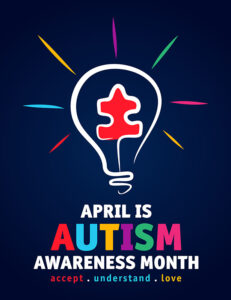Autism now affects 1 in 36 U.S. children, up from the 1 in 44 reported in 2021. Why?
By Deborah Jeanne Sergeant
 If it seems like you hear about autism spectrum disorder more than you used to, you’re not imagining things.
If it seems like you hear about autism spectrum disorder more than you used to, you’re not imagining things.
The Centers for Disease Control and Prevention reports that the prevalence has increased from 1 in 44 US children to 1 in 36.
Andy Shih, chief science officer at Autism Speaks in New York City, said the perceived increase in prevalence reflects progress in awareness, as well as earlier identification and diagnosis.
“More people have become aware of the signs of autism and the tools that can assist in identifying it, the more compelled they are to seek an official diagnosis,” Shih said. “While the prevalence increase is an indication of progress in certain aspects, it also reiterates the need for increased funding for autism research and services throughout the lifespan and spectrum and a need for earlier screenings as the average age of diagnosis in the U.S. is still 4 to 5 years old when we know that autism can be reliably diagnosed by 18 months to 2 years.”
Screening at the pediatrician’s office can help identify more children who would benefit from intervention.
Autism Speaks offers tools to address these needs, including the M-CHAT checklist. This screening list poses a series of questions for toddlers to help identify signs of autism and assess whether they may need further evaluation. Shih also said that the World Health Organization’s virtual Caregivers Skill Training Program, developed in collaboration with Autism Speaks, provides a self-guided platform to teach caregivers therapies and services skills that can foster the development of their child.
“Intentional, targeted outreach, as well as training culturally informed service providers can also make a difference in delivering accessible quality care to the growing number of children with autism, especially in underserved communities,” Shih said.
The Autism Speaks Autism Care Network forms a partnership among 20 participating medical centers across the U.S. and Canada and uses patient insights to improve person and family-centered autism care.
Local providers agree that increased awareness and screening has led to the rise in diagnosis.
“To a large extent, the increase in the diagnostic rate is related to two factors,” said Henry Roane, Ph.D., executive director of the Golisano Center for Special Needs and chief of development, behavior, and genetics in the department of pediatrics at Upstate Medical University. “One, health care providers are getting better at recognizing signs of ASD which leads to better screening and early identification. The second factor is that society as a whole has become more aware of ASD, particularly in the media. This has likely led to more people pursuing diagnostic assessments.”
Roane is also the Gregory S. Liptak professor of child development at Upstate, in addition to being the executive director of Golisano Center for Special Needs, chief of the Division of Development, Behavior and Genetics and Department of Pediatrics at SUNY Upstate Medical University.
Recent research and improved diagnostic tools have helped Theresa McIntyre, speech-language pathologist for the Golisano Center for Special Needs, broach the subject of ASD with parents.
“We tend to feel more comfortable bringing up the subject of ASD to parents sooner than we have done in previous years,” she said.
This can help families access earlier the resources that can help their children.
More healthcare providers are identifying and seeking to address bias when treating people of color. This may also be a factor in the growth of ASD diagnoses.
“Research had typically shown higher ASD prevalence for white children, yet more recent studies have shown these rates becoming more equivalent across race,” said Sean Smith, PhD, a clinical provider a clinical provider in the forthcoming BioBehavioral Health Unit at Upstate Medical University. “This could suggest that the overall increase may also be related to better diagnostics or access to diagnostics for specific populations who were previously under diagnosed.”
Autism By the Numbers
From the Centers for Disease Control and Prevention:
• About 1 in 36 children has been identified with autism spectrum disorder according to estimates from CDC’s Autism and Developmental Disabilities Monitoring Network.
• ASD is reported to occur in all racial, ethnic and socioeconomic groups.
• ASD is nearly four times more common among boys than among girls.
• About one in six (17%) children aged 3–17 years were diagnosed with a developmental disability, as reported by parents, during a study period of 2009-2017. These included autism, attention-deficit/hyperactivity disorder, blindness and cerebral palsy, among others.

